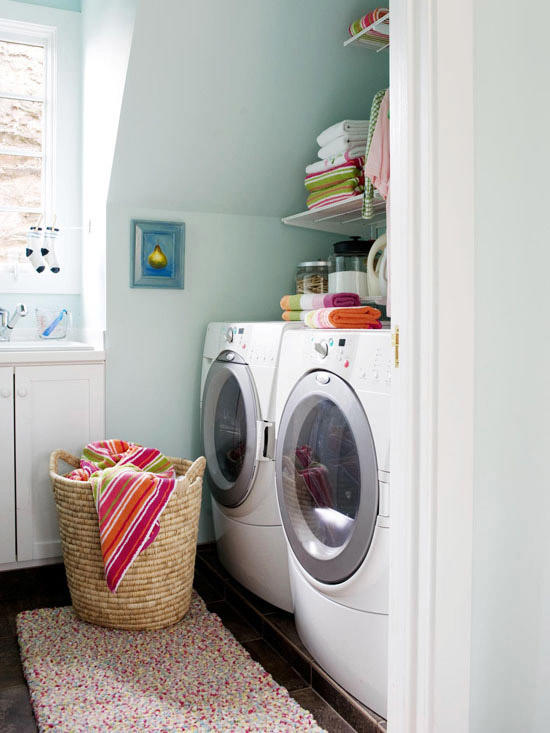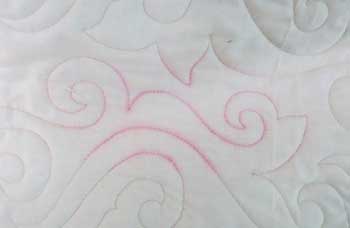Shadywood Quilts
Professional Machine Quilting
To Wash or Not To Wash
Washing Quilt Fabric
 OK, I admit. I NEVER prewash fabrics - Except ... OK, there are always exceptions, but for the most part - NO, I don't wash them. Now, for those exceptions.
OK, I admit. I NEVER prewash fabrics - Except ... OK, there are always exceptions, but for the most part - NO, I don't wash them. Now, for those exceptions.
- Scraps and fabrics from unknown origins
- Cheap Fabric (i.e. from Wally World or JoAnn's)
- Recycled fabrics from clothing
- Smelly fabrics
You have probably read lots of articles that say not to wash your quilt in a washing machine - to lay it in a bathtub and soak it. Right, ain't gonna happen with my back. But, there is a TRICK to washing scraps, ANY sized yardage or a quilt in the washing machine.
It's easy to eliminate nearly all of the strings on yardage. Just clip off a little triangular section from each corner of fabrics before you wash them. Try about 1/2" or a little less. You'll still see a bit of fraying, but not enough to create bunches of knots.
DO NOT AGITATE... DO NOT AGITATE... DO NOT AGITATE
- fill the tub-style washing machine with lukewarm water and a tiny bit of detergent* (2 Tablespoons for a full machine).
- Load the machine with scraps and/or yardage
- KEEP THE MACHINE LID OPEN, to keep it from **accidentally** agitating.
- With your hand, or a large spoon, swish the fabrics around in the
tub. - Some dyes do not release right away; so try to leave fabrics in the
water for at least 20 minutes. - Continue swishing the fabric periodically for the 20 minutes.
- Drain/spin.
- Refill tub... and KEEP THE MACHINE LID OPEN.
- Swish with your hand.
- Drain/spin.
DO NOT AGITATE... DO NOT AGITATE... DO NOT AGITATE
*Use a very gentle soap like Orvus Soap. Orvus Soap contains so phosphates or chemicals that can damage your quilt. You can find Orvus Soap at your local quilt shop, or you can order it from me in smaller 8 fl oz containers.
Reasons they tell you to wash your fabric
 Prevents Shrinkage - Fabrics like cotton, wool, silk, and linen almost always shrink when washed. When cutting patches of fabric, you hope the fabric doesn't shrink after the first time being laundered.
Prevents Shrinkage - Fabrics like cotton, wool, silk, and linen almost always shrink when washed. When cutting patches of fabric, you hope the fabric doesn't shrink after the first time being laundered.
(My Note: Most modern cotton quilting fabrics have minor shrinkage. You can reduce most shrinkage from using a 'hot -steam iron")- Prevents Colors From Running or Bleeding - Pre-washing fabric prevents it from damaging other fabrics when thrown in the wash after sewing. This is especially important if the fabric you're using is made with a multitude of colors.
(My Note: OK mostly important if you OLDER fabrics that are red or navy as in example to the right. Quilt had a red border from OLD red fabric) - Eliminates Fabric's Chemicals - Most fabric comes soaked with resinous solutions that make them look more vibrant and appealing. Eliminating these chemicals prevents an allergic reaction to those with sensitive skin.
(My Note: Formaldehyde is used in fabrics to enhance colors and reduce wrinkles.**) - Removes Wrinkles - Pre-washing a fabric softens the material, which makes it easier to iron later on.
(My Note:I find that pre-washing actually INCREASES wrinkles as it removes the 'sizing' that gives the pressed look off of the bolt)
Drying the Fabric
I'm sure everyone has thrown raw edge fabric in the dryer and ended up with lots of knots and twisted fabrics. What a mess.
You might try laying the fabric on one of those folding racks - or even outside on the clothesline. (Many days in Houston, I must admit that it might take days to dry with all the humidity!). You can dry smaller scraps by ironing them (be sure to turn the steam off).
What I have noticed is that the tighter the weave of the fabric, the better they turn out in the dryer. Homespuns are a very loose weave (compared to batiks) and you can pretty much bet that the homespuns are going to shrink up in the dryer.
Tip from a reader:
One time, after I completed arranging inherited squares into 25-patches in an intentional and complicated color-pattern on my design wall, I realized that the pre-cut 2-1/2-inch squares had not been washed; lots of bleeders; darks, reds, turquoises.
I had been making a T-shirt quilt, so I took the plain backs of the T-shirts that would have been thrown away, and transferred the 25-patch blocks to the T-shirt fabric, and pinned them on with basting/safety pins.
I ran these through a **DO NOT AGITATE** wash cycle (see above), and they all came out perfectly... and in their original order.
If you have lots of fat quarters or yardage in the SAME COLOR FAMILIES, use a safety-pin and pin three or four fat quarters together at the corners. Wash
them as a unit. Really cuts down on the wrinkles and twisting.
For larger cuts of fabric, pin the folded fabric in the corners and along the sides. I've pinned as many as eight layers... It can be difficult to pin through, but don't skimp on the safety pins. The more yardage... the larger the folded-over pieces need
to be... maybe as large as a beach towel or bath sheet.
Only pin the eight EDGES to keep the fabric from bunching and wrinkling;
the center will remain unpinned so that the water can still freely pass
through the fabric to remove dyes and chemicals. Fewer layers are
preferred, but 8-yard cuts will require more layers.
** Formaldehyde can be used to enhance wrinkle resistance in some clothing and textiles, especially those made of cotton. The Consumer Product Safety Commission reviewed formaldehyde in clothing in the 1980s and determined that the levels found did not pose a public health concern.
***Many cotton fabrics are treated with permanent-press or no-iron finishes that release formaldehyde. Even if not stated on the label, all polyester/cotton-blend fabrics have formaldehyde finishes.
You may also be interested in:
Back to Tips & Tricks Resource Page
Original Post: February 2014, Updated August 2022